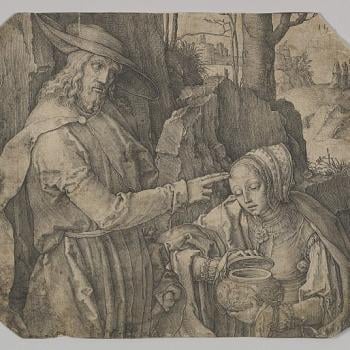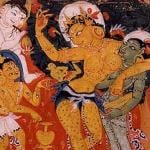I was visiting the Christian Century website where I found myself reading an essay on the emergent church movement through a look at Jacob’s Well in Kansas City, MO. What struck me and made me want to write this reflection was a quote written on one of the walls at that church from Stanley Hauerwas.
Professor Hauerwas is not someone I would normally quote. He is sometimes described theologically as a “paleo-orthodox” Christian, something I have no particular interest in. Admittedly his association with something called “narrative theology” is more intriguing for me, if in an abstract and distant sort of way. But then there’s that quote.
“The work of Jesus was not a new set of ideals or principles for reforming or even revolutionizing society, but the establishment of a new community, a people that embodied forgiveness, sharing and self-sacrificing love in its rituals and discipline. In that sense, the visible church is not to be the bearer of Christ’s message, but to be the message.”
It triggered a series of thoughts, particularly about image, and what an image might be, and specifically what an image of the liberal church might be.
I’m a child of the Christian tradition, raised a Baptist of the most conservative stripe. Today as a Unitarian Universalist and a Buddhist I’ve moved a long way from that theology, but nonetheless I have no desire to renounce my Christian heritage. I’m endlessly grateful for what it offered, in particular for the image of Jesus as a sacred thing in itself. I know those who read this are not all informed by either the story of Jesus or his various images. You weren’t raised Christian. And maybe suffered because you weren’t raised Christian. Or, you suffered too much because you didn’t fit the Christian parameters of your Christian religion. Whatever the case might be, for you there may be other images of value. But near as I can tell the universal is only ever found in the particular, and I feel a need to reflect further on sacred image, which for me starts with a picture of Jesus. And I think there’s a pointer here for those of us who embrace liberal religion in such a reflection.
I can’t believe the theology, the story that Jesus is the second person of the Trinity, that he is of the Godhead in a way no other person is, that he descended from Heaven to suffer on our behalf, to ransom us from our just deserts as sinning humans, eternal damnation. I can’t believe that our salvation is found in simply believing the story and accepting that vicarious atonement. Just don’t believe it. It’s not even remotely true, near as I can tell. Best as I can tell.
But then there’s the image, that icon, that picture which is Jesus. For me it started with that ubiquitous “Head of Christ” by Warner Sallman which I remember from every Baptist church of my childhood. Briefly, in my young adolescence, I was taken with Ralph Kovac’s “Laughing Jesus.” There is no reference in the New Testament to Jesus laughing, tellingly the famous shortest sentence about Jesus is “Jesus wept.” But somehow this made what even then I knew was “bad” art compelling. It also opened doors of doubt and of longing, at this point beyond my articulation. Later, on my way out the door, the image became, if briefly Salvador Dali’s “Sacrament of the Last Supper” (not as some might think, his “Christ of St John of the Cross” which is just too dependent upon that story I don’t find true) or at least the detail of Jesus in that painting, more mysterious than Sallman’s Jesus, vastly better art than Kovac’s, but disconcerting, and somehow inviting. But that was just a glance over my shoulder, already being informed deeply by other perspectives. After I left the Christian religion I discovered other images that have further informed my imagination, African and Asian Jesus’, Jesus as mother, as well as various Orthodox icons depicting Jesus.
Each of these images, all by themselves, without the necessity of that story of a dying and ascending god, are pregnant with meaning. I suspect there’s a picture like this for each of us, an image, an icon.
What exactly emerges is different for each of us. It happens only within a conversation between each of us as individuals and that image. Informed, of course, by the communities within which we are born and raised. Informed by our suffering and our joy; informed by all that makes us who we are. The word icon comes from the Greek and literally means image. But we say icon rather than image because there is something peculiar about sacred image.
And it’s here I find myself coming back to Hauerwas’s quote: “The work of Jesus was not a new set of ideals or principles for reforming or even revolutionizing society, but the establishment of a new community, a people that embodied forgiveness, sharing and self-sacrificing love in its rituals and discipline. In that sense, the visible church is not to be the bearer of Christ’s message, but to be the message.”
As I read these two sentences I feel I get a hint of what an icon is for, or a picture that might be. It is an image that draws something out of us. For me when I think of liberal religious communities, and in particular the community to which I belong, I think of image, icon and I think of these two sentences.
Our work as religious liberals is not to bring a new set of ideals or principles for reforming or even revolutionizing society, but the establishment of a new community, a people that embody forgiveness, share with one another, manifesting a self-sacrificing love in our rituals and discipline. In that sense, the visible community is not to be the bearer of any message, but to be the message. To be the image.
We are the image of love and possibility when we covenant to come together. We, as we are, as we struggle to be better and deeper, a little more humble and a lot more grateful, are the vision. If we really embrace such a thing, I suspect we might even be taking a few steps toward the healing of the world as well as our own hearts.












